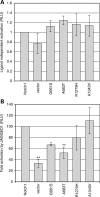NOTCH1 mutations in individuals with left ventricular outflow tract malformations reduce ligand-induced signaling
- PMID: 18593716
- PMCID: PMC2722892
- DOI: 10.1093/hmg/ddn187
NOTCH1 mutations in individuals with left ventricular outflow tract malformations reduce ligand-induced signaling
Abstract
Congenital aortic valve stenosis (AVS), coarctation of the aorta (COA) and hypoplastic left heart syndrome (HLHS) are congenital cardiovascular malformations that all involve the left ventricular outflow tract (LVOT). They are presumably caused by a similar developmental mechanism involving the developing endothelium. The exact etiology for most LVOT malformations is unknown, but a strong genetic component has been established. We demonstrate here that mutations in the gene NOTCH1, coding for a receptor in a developmentally important signaling pathway, are found across the spectrum of LVOT defects. We identify two specific mutations that reduce ligand (JAGGED1) induced NOTCH1 signaling. One of these mutations perturbs the S1 cleavage of the receptor in the Golgi. These findings suggest that the levels of NOTCH1 signaling are tightly regulated during cardiovascular development, and that relatively minor alterations may promote LVOT defects. These results also establish for the first time that AVS, COA and HLHS can share a common pathogenetic mechanism at the molecular level, explaining observations of these defects co-occurring within families.
Figures



References
-
- Pradat P., Francannet C., Harris J.A., Robert E. The epidemiology of cardiovascular defects, part I: a study based on data from three large registries of congenital malformations. Pediatr. Cardiol. 2003;24:195–221. - PubMed
-
- McBride K.L., Marengo L., Canfield M., Langlois P., Fixler D., Belmont J.W. Epidemiology of noncomplex left ventricular outflow tract obstruction malformations (aortic valve stenosis, coarctation of the aorta, hypoplastic left heart syndrome) in Texas, 1999–2001. Birth Defects Res. A Clin. Mol. Teratol. 2005;73:555–561. - PMC - PubMed
-
- Ferencz C., Loffredo C.A., Corea-Vilasenor A., Wilson P.D. In: Genetic and Environmental Risk Factors of Major Cardiovascular Malformations. Anderson R., editor. Vol. 5. Armonk, NY: Futura Publishing Co. Inc; 1997. pp. 165–225.
-
- Centers for Disease Control and Prevention (CDC) Hospital stays, hospital charges, and in-hospital deaths among infants with selected birth defects—United States 2003. MMWR Morb. Mortal. Wkly Rep. 2007;56:25–29. - PubMed
-
- Minino A.M., Heron M.P., Smith B.L. Deaths: preliminary data for 2004. Natl. Vital Stat. Rep. 2006;54:1–49. - PubMed
Publication types
MeSH terms
Substances
Grants and funding
LinkOut - more resources
Full Text Sources
Molecular Biology Databases

